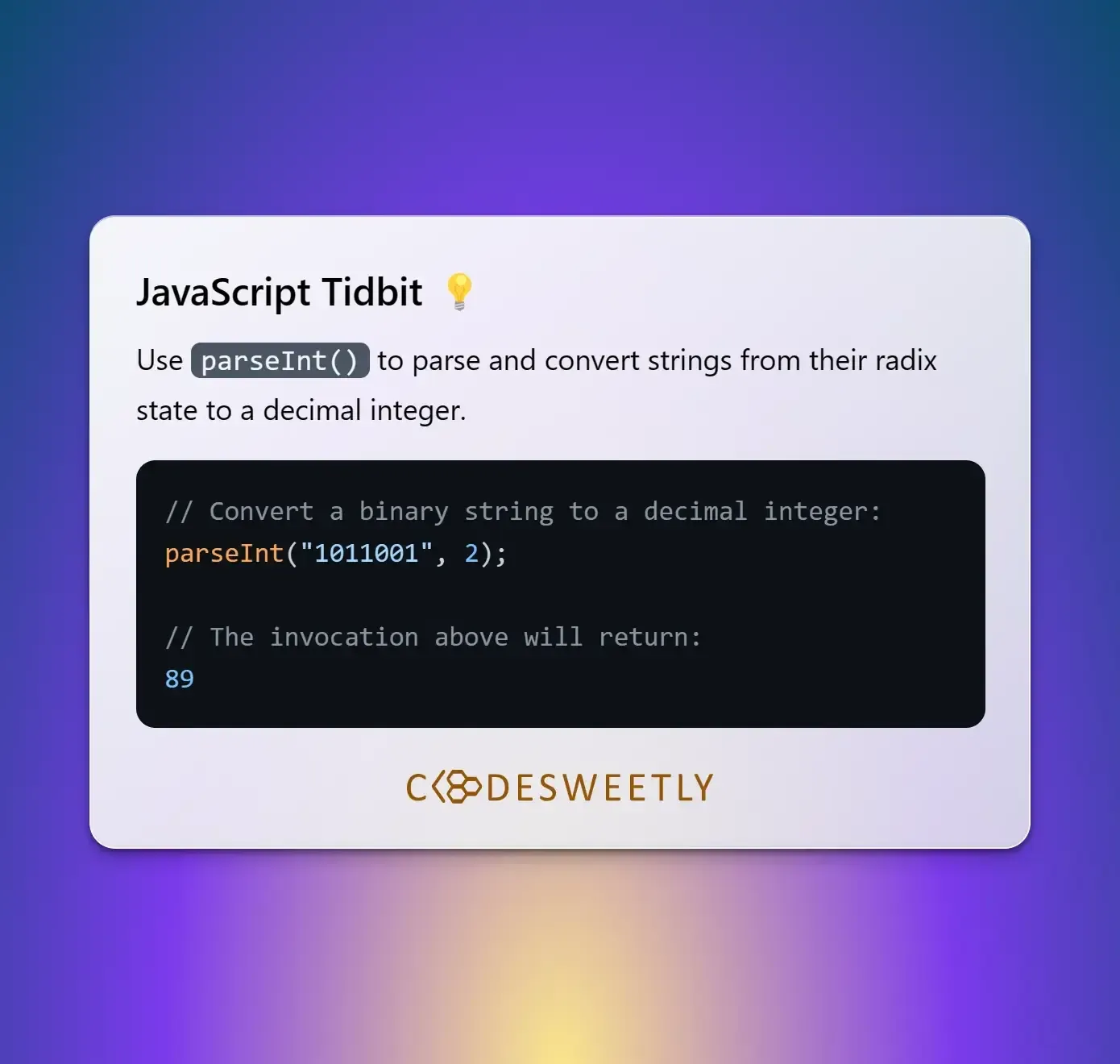parseInt() in JavaScript – How to Convert String to Decimal
Whenever you invoke parseInt(), the method does the following:
- It parses (analyzes) its string argument.
- It converts the string argument from its radix state to a decimal integer.

Use JavaScript’s parseInt() method to convert strings from their radix state to a decimal integer.
Syntax of the parseInt() Method
Section titled “Syntax of the parseInt() Method”parseInt() accepts two arguments. Here is the syntax:
parseInt("string", radix);Argument 1: string
Section titled “Argument 1: string”A string argument is the first argument accepted by the parseInt() method. It is a required argument specifying the string value you want the computer to parse (analyze).
Argument 2: radix
Section titled “Argument 2: radix”A radix is the second argument accepted by the parseInt() method. It is an optional argument specifying the string argument’s base.
Example 1: Convert Binary String to Decimal Integer
Section titled “Example 1: Convert Binary String to Decimal Integer”parseInt("1011001", 2);
// The invocation above will return: 89Example 2: Convert Hexadecimal String to Decimal Integer
Section titled “Example 2: Convert Hexadecimal String to Decimal Integer”parseInt("4fc", 16);
// The invocation above will return: 1276Example 3: Convert Decimal String to Decimal Integer
Section titled “Example 3: Convert Decimal String to Decimal Integer”parseInt("45", 10);
// The invocation above will return: 45Note that the snippet above is equivalent to:
parseInt("45");
// The invocation above will return: 45Important Stuff to Know about the Radix Argument
Section titled “Important Stuff to Know about the Radix Argument”Below are three essential pieces of info you need to know about the radix argument.
Info 1: Always provide a radix argument
Section titled “Info 1: Always provide a radix argument”It is best practice to specify the radix argument because it does not always default to base 10 (decimal).
For instance, suppose you omit the radix and begin the string argument with "0X" or "0x" (number zero followed by the upper-case or lower-case letter X). In that case, the computer will use 16 (hexadecimal) as the radix.
Example 1: Begin parseInt()’s string argument with "Ox" without providing a radix
Section titled “Example 1: Begin parseInt()’s string argument with "Ox" without providing a radix”parseInt("0x95");
// The invocation above will return: 149Note that the snippet above is equivalent to:
parseInt("0x95", 16);
// The invocation above will return: 149Example 2: Begin parseInt()’s string argument with "Ox" while providing a radix
Section titled “Example 2: Begin parseInt()’s string argument with "Ox" while providing a radix”parseInt("0x95", 35);
// The invocation above will return: 40745Info 2: Radix must be an integer between 2 and 36 inclusive
Section titled “Info 2: Radix must be an integer between 2 and 36 inclusive”The radix argument must be an integer between 2 and 36 inclusive. Otherwise, parseInt() will return NaN (Not a Number).
Example 1: 1 is an invalid radix value
Section titled “Example 1: 1 is an invalid radix value”parseInt("45", 1);
// The invocation above will return: NaNExample 2: 37 is an invalid radix value
Section titled “Example 2: 37 is an invalid radix value”parseInt("45", 37);
// The invocation above will return: NaNExample 3: 36 is a valid radix value
Section titled “Example 3: 36 is a valid radix value”parseInt("45", 36);
// The invocation above will return: 149Example 4: 18 is a valid radix value
Section titled “Example 4: 18 is a valid radix value”parseInt("45", 18);
// The invocation above will return: 77Info 3: The first invalid character ends parseInt()’s analysis
Section titled “Info 3: The first invalid character ends parseInt()’s analysis”Suppose parseInt() encounters a character that is not a valid number in the specified radix numeral system. In such a case, the computer will do the following:
- It will ignore all characters from the invalid one to the end of the string.
- It will convert only the characters preceding the invalid one.
Example 1: The first character is not a binary numeral
Section titled “Example 1: The first character is not a binary numeral”parseInt("5111", 2);
// The invocation above will return: NaNThe snippet above returned NaN because the string argument’s first character (5) is an invalid binary numeral. Therefore, the computer ignored all the string’s characters.
Example 2: The second character is not a binary numeral
Section titled “Example 2: The second character is not a binary numeral”parseInt("1511", 2);
// The invocation above will return: 1The snippet above returned 1 because the string argument’s second character (5) is an invalid binary numeral. Therefore, the computer converted only the first character.
Example 3: The third character is not a binary numeral
Section titled “Example 3: The third character is not a binary numeral”parseInt("1151", 2);
// The invocation above will return: 3The snippet above returned 3 because the string argument’s third character (5) is an invalid binary numeral. Therefore, the computer converted only the first and second characters.
Example 4: The fourth character is not a binary numeral
Section titled “Example 4: The fourth character is not a binary numeral”parseInt("1115", 2);
// The invocation above will return: 7The snippet above returned 7 because the string argument’s fourth character (5) is an invalid binary numeral. Therefore, the computer converted only the first, second, and third characters.